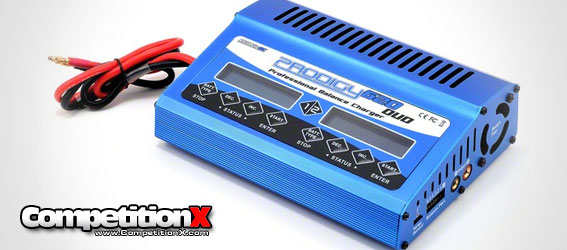
This is the ProTek R/C Prodigy 620 DUO DC Battery Charger. There is no such thing as too much power and the Prodigy 620 DUO is an impressive charger that has the power you need to get your batteries charged quickly, with the features, reliability, and customer support you have come to expect from ProTek R/C! The Prodigy 620 DUO features two independent 400 Watt channels, each with its own independent control panel, LCD display, balance ports and sensor ports. Plus, each channel has its own blue backlit LCD display and the white characters to provide clear visibility in any environment.
Additionally, the Prodigy 620 DUO can charge LiPo, LiFe, or Li-Ion batteries up to 6S, 15-cell NiCd or NiMH batteries, and lead-acid batteries up to 20V. With the ability to fast charge, balance charge, and storage charge lithium cells, you can easily tailor the charge process to suit your needs, while individual cell voltage can be monitored during balance mode charging, allowing you to identify an imbalance in the cells and spot a weak cell before it becomes a problem. Other features include a dual-fan cooling system that utilizes a push-pull design that will keep the charger cool, even when working at maximum capacity. Plus it’s backed by ProTek R/C’s legendary customer support, so no matter what your charging needs may be, the 620 DUO has you covered.
NOTE: To take advantage of the Prodigy 620 DUO’s full power capability, the power source should be 15V-18V DC, and output power should be capable of 1000W or higher. A low power, low quality DC power source could potentially damage your Prodigy 620 DUO charger. We recommend the ProTek R/C “Super Pro 1000” DC power supply PTK-PRO-1000W-SP.
Features:
• Optimized Operating Software: An optimized “Auto” function controls the charge rate during the charging and discharging process. This will help to prevent damage due to user error. If there is a malfunction, the circuit will be disconnected automatically and an alarm will sound. All operating modes are controlled through a two-way communication process between the charger and the battery in order to maintain maximum safety, and all settings can be configured by the user.
• Internal Lithium Battery Balancer: Each channel features an individual cell voltage balancer. An external balancer is not required for balance charging.
• Individual Cell Discharge Balancing: When discharging, each cell is monitored and balanced individually. If the voltage of any cell is abnormal, an error message will be displayed and the process will be terminated.
• Lithium Battery Adaptability: Compatible with the three most common Lithium battery types: LiPo, Li-ion, and LiFe.
• Multiple Lithium Battery Charge Modes: Programming allows Fast Charge, Balance Charge or Storage Charge Modes for LiPo, Li-ion, and LiFe batteries.
• “Fast” Charge Mode: Reduces charging time, but does not balance the cells and charges the battery to approximately 90% capacity.
• “Balance” Charge Mode: Monitors individual cell voltage, keeps the cells within an acceptable voltage range and charges the pack to peak capacity.
• “Storage” Charge Mode: Used for long-term battery storage. Adjusts the voltage level so the battery will not be damaged during storage.
• Maximum Safety Through Delta-Peak Technology: The automatic charge termination program uses Delta-Peak voltage detection. When the battery’s voltage exceeds the threshold, the process will be terminated automatically.
• Automatic Charging Current Limit: The upper limit of the charge current can be set for charging NiCd or NiMH batteries. This is useful for NiMH batteries with low resistance and capacity in the ‘AUTO’ charging mode.
• Capacity Limit: The charging capacity is always calculated as the charging current multiplied by time. If the charging capacity exceeds the limit, the process will be terminated automatically when the charger reaches the maximum value.
• Temperature Threshold: The batteries internal chemical reaction can cause the temperature of the battery to rise during charging. If the temperature limit is reached, the charging process will be terminated. This function is only available when using the temperature probe and its parameters are user-specified.
• Processing Time Limit: The user can set the maximum charging time. If the charging time exceeds the limit, the process will be terminated automatically.
• 10 User Presets: Customize 10 individual presets, each with different parameters set for a particular battery type. This allows the user to “call up” the settings for a particular battery without additional programming needed.
• Cyclic Charging/Discharging: Batteries can be set Charge/Discharge or Discharge/Charge for up to 5 cycles.
Specifications:
Operating Voltage Range: 12-18 Volts DC
Max Charge Power: 2×400 watts
Max Discharge Power: 2×25 watts
Charge Current Range: 0.1-20.0A
Discharge Current Range: 0.1-5.0A
Current Drain for Balancing LiPo/Li-ion/LiFe: 300mA/cell
LiPo/Li-ion/LiFe Cell Count: 1-6 cells
NiCd/NiMH Cell Count: 1-15 cells
Pb Battery Voltage: 2V-20V
Dimension: 200x140x55mm
Includes:
(1) Prodigy 620 DUO Charger
(2) JST-XH Balancing Adapter
(1) Alligator Clip Charging Cable
(2) 18AWG Wire Charging Cable
(2) Plug-in Battery Clamps
 [source: www.amainhobbies.com]
[source: www.amainhobbies.com]
 CompetitionX CompetitionX is the most up-to-date source for RC Car News, Reviews and Videos for Radio Control. We also have the most comprehensive Manual Database on the web.
CompetitionX CompetitionX is the most up-to-date source for RC Car News, Reviews and Videos for Radio Control. We also have the most comprehensive Manual Database on the web. 


